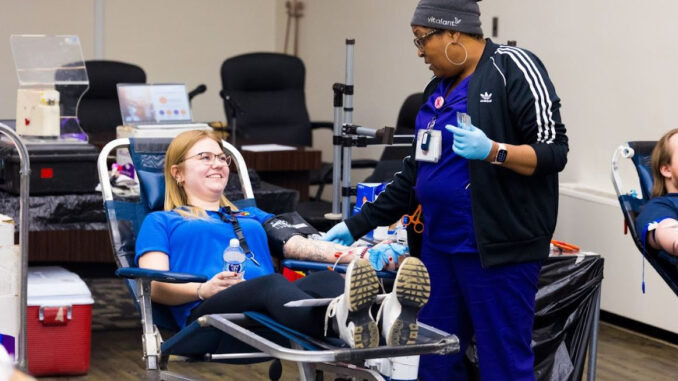
Naomi Girson | Staff Writer
A local nonprofit is taking care this March for Bleeding Order Awareness Month, serving the community one pint at a time.
Vitalant, a nonprofit healthcare company dedicated to healthy blood donation and collection, is traveling throughout the Pittsburgh area to collect blood. Especially during this time of year, when spring storms can cause blood drive cancellations and keep donors from coming out, Vitalant said in a news release that donation is vital. Year round, an adequate blood supply must be ready for patients every day before it’s needed — “blood cannot be manufactured,” said Linda Nevies.
Nevies is a Vitalant employee, and she supervised Vitalant’s stop on Monday at the Elizabeth Municipal Building in Elizabeth, Pa.
Township Manager Greg Butler has worked at the Elizabeth municipal building for the last three years. Since he stepped into his position, he has overseen numerous blood drives.
“People need it. I think it’s people helping other people,” Butler said. “It’s a nice community event too, it brings people in, it feels like a community event but it reaches beyond the community, so I think it’s a great thing.”
They are offering many incentives for blood donation, including free entry into a gift card giveaway totaling $5,000 and numerous pieces of free merchandise. Students can find the full schedule for Vitalant blood drives on their website. Some locations this March include local hospitals, universities in Oakland and businesses in Downtown Pittsburgh.
Red Cross Blood Donation illustrates the major impact giving can have. Just one pint of blood can save more than one person, their website said. It is essential to always be collecting blood because of the immense amounts that are used everyday in hospitals, during surgeries and procedures. O negative is especially useful in blood donations because O negative is the universal donor, so anyone can receive O negative blood.
“We’re trying to do two or three per year, based on their schedule. I think we’ve averaged about 12 people, which they say is really good,” Butler said.
He also said that he would donate later in the day, and he hopes that if he ever needed blood it would be there.
Jessica Gronlund, 25-years-old, donated her blood on Monday, and she found the location extremely convenient since she works as an executive assistant in the very same building. She is a recurring donor.
“I never did it when I had the opportunity in high school, but doing it now … that I’m older I realized how many people need it and can’t get it so just the thought of saving someone that could need it and hopefully it’s there if I ever need it.”
Ethan Thoma, an intern at the municipal building, has donated since he was able to at 16. Five years later, he still donates every chance he gets, as does his father, who works for the township as well.
The two of them donate blood for the same reason — for his mother, Thoma said.
“Pretty much my entire childhood my mom was in the hospital and she got a lot of blood transfusions,” he said. By donating blood early on, Thoma said he was able to save his mother’s life. His hope is to help even more lives in the future through continued donation.
According to Vitalant’s website, every two seconds, someone needs blood or platelets, and they work to collect both.
The two, along with plasma donation, are used for different procedures, but no donation is more painful than any other, according to Tory Hartley, a full time employee for Vitalant. Donors have the choice to donate double the amount of blood through the Power Red donation. A simple machine in this process collects just their red blood, as opposed to whole blood, and it takes half an hour. But since they are given fluids as they are donating they do not have to wait before leaving, making the length of time the same either way.
When a person donates on the Power Red machine, they have to wait 120 days to donate again, Hartley said. Without, they can donate every 56 days.
Donating blood is a service that can provide to virtually anyone, and it has the ability to save lives.
“It’s just the fact that people come in here to volunteer. They actually take time out of their day to come here,” Hartley said. “That’s the best part of the day, because somebody cares.”
